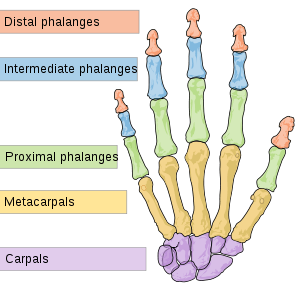Boutonniere deformity
| Boutonniere deformity | |
|---|---|
|
Human hand bones (Joints visible but not labeled.) | |
| Classification and external resources | |
| Specialty | rheumatology |
| ICD-10 | M20.0 |
| ICD-9-CM | 736.21 |
| eMedicine | orthoped/24 |
Boutonniere deformity is a deformed position of the fingers or toes, in which the joint nearest the knuckle (the proximal interphalangeal joint, or PIP) is permanently bent toward the palm while the farthest joint (the distal interphalangeal joint, or DIP) is bent back away (PIP flexion with DIP hyperextension). It is commonly caused by injury[1] or by an inflammatory condition like rheumatoid arthritis, or genetic conditions like Ehlers Danlos Syndrome.
Stages
- Mild extension lag, passively correctable
- Moderate extension lag, passively correctable
- Mild flexion contracture
- Advanced flexion contracture
Higher numbers indicate a more severe problem and greater likelihood of a poor final outcome.
Pathophysiology
This flexion deformity of the proximal interphalangeal joint is due to interruption of the central slip of the extensor tendon such that the lateral slips separate and the head of the proximal phalanx pops through the gap like a finger through a button hole (thus the name, from French boutonnière "button hole"). The distal joint is subsequently drawn into hyperextension because the two peripheral slips of the extensor tendon are stretched by the head of the proximal phalanx (note that the two peripheral slips are inserted into the distal phalanx, while the proximal slip is inserted into the middle phalanx). This deformity makes it difficult or impossible to extend the proximal interphalangeal joint.
See also
References
- "Boutonniére Deformity". Your Orthopaedic Connection. American Academy of Orthopaedic Surgeons.
External links
- Boutonniere_deformity_of_the_thumb_mp_joint at the Duke University Health System's Orthopedics program
- http://medicine.ucsd.edu/clinicalimg/upper-hand-boutonniere.html
- http://www.merck.com/mmpe/sf/multimedia/Photo2sec04ch34/t/sec04-ch034-ch034b.html
- Boutonniere Deformity at eMedicine
- MRI sequence of disruption of the extensor tendon slip
